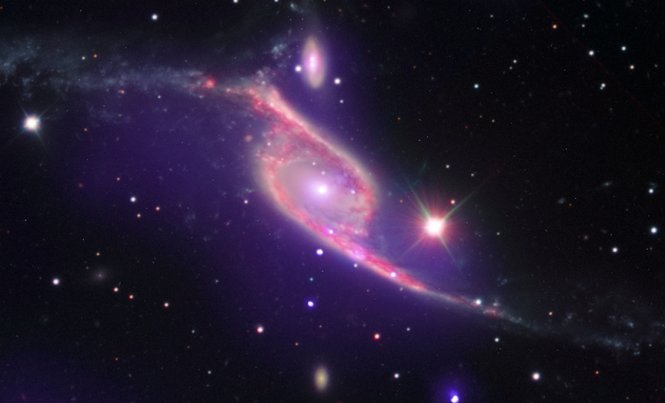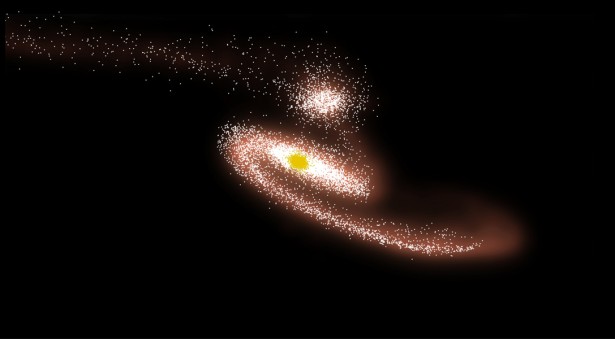Astronomers explore NGC 6872, declare it largest known spiral galaxy

NGC 6872 is a barred spiral galaxy 212 million light years away from Earth in the southern constellation Pavo. With its exceptionally large spiral arms, it spans more than 522,000 light-years, making it more than five times the size of our Milky Way galaxy. For decades, this spectacular galaxy has ranked among the biggest stellar systems. Now, based on archival data from NASA’s Galaxy Evolution Explorer (GALEX) mission, astronomers from USA, Chile and Brazil have announced it the largest-known galaxy of its type.
Astronomers suggest galaxy’s unusual size and appearance is due to its interaction with a disk galaxy having only about one-fifth of its mass and known as IC 4970. Strangely, the two galaxies are not merging into one, contrary to the common astronomical belief that large galaxies grow through mergers and acquisitions – assembling over billions of years by absorbing smaller systems. Instead, it might lead to development of a new small galaxy in this case, speculations say. Team member Duilia de Mello, a professor of astronomy at Catholic University said,
“The northeastern arm of NGC 6872 is the most disturbed and is rippling with star formation, but at its far end, visible only in the ultraviolet, is an object that appears to be a tidal dwarf galaxy similar to those seen in other interacting systems.”
The tidal dwarf candidate is brighter in the ultraviolet than other regions of the galaxy, a sign it bears a rich supply of hot young stars less than 200 million years old. By analyzing distribution of energy by wavelength, the team uncovered a distinct pattern of stellar age along the galaxy’s two prominent spiral arms. The youngest stars appear in the far end of the northwestern arm, within the tidal dwarf candidate, and stellar ages skew progressively older toward the galaxy’s center.
 Computer simulations of the collision between NGC 6872 and IC 4970 reproduce the basic features of the galaxies as we see them today. They indicate that IC 4970’s closest encounter occurred 130 million years ago and that the smaller galaxy followed a path (dashed curve) close to the plane of the spiral’s disk and in the same direction it rotates. Image credit:
Computer simulations of the collision between NGC 6872 and IC 4970 reproduce the basic features of the galaxies as we see them today. They indicate that IC 4970’s closest encounter occurred 130 million years ago and that the smaller galaxy followed a path (dashed curve) close to the plane of the spiral’s disk and in the same direction it rotates. Image credit:NASA’s Goddard Space Flight Center, after C. Horellou (Onsala Space Observatory) and B. Koribalski (ATNF)
The southwestern arm displays the same pattern, which is likely connected to waves of star formation triggered by the galactic encounter.
A 2007 study by Cathy Horellou at Onsala Space Observatory in Sweden and Baerbel Koribalski of the Australia National Telescope Facility developed computer simulations of the collision that reproduced the overall appearance of the system as we see it today. According to the closest match, IC 4970 made its closest approach about 130 million years ago and followed a path that took it nearly along the plane of the spiral’s disk in the same direction it rotates. The current study is consistent with this picture.
As in all barred spirals, NGC 6872 contains a stellar bar component that transitions between the spiral arms and the galaxy’s central regions. Measuring about 26,000 light-years in radius, or about twice the average length found in nearby barred spirals, it is a bar that befits a giant galaxy.
The team found no sign of recent star formation along the bar, which indicates it formed at least a few billion years ago. Its aged stars provide a fossil record of the galaxy’s stellar population before the encounter with IC 4970 stirred things up. Team member and Goddard astrophysicist Eli Dwek said,
“Understanding the structure and dynamics of nearby interacting systems like this one brings us a step closer to placing these events into their proper cosmological context, paving the way to decoding what we find in younger, more distant systems.”
Talking about significance of GALEX mission, lead scientist Rafael Eufrasio, who presented the findings at the American Astronomical Society meeting in Long Beach, Calif said, “Without GALEX’s ability to detect the ultraviolet light of the youngest, hottest stars, we would never have recognized the full extent of this intriguing system.” Apart from GALEX mission’s archival data, researchers also analyzed archival data from the European Southern Observatory’s Very Large Telescope, the Two Micron All Sky Survey and NASA’s Spitzer Space Telescope in order to study the galaxy across the spectrum.
Source: NASA
Featured image: X-ray: NASA/CXC/SAO/M.Machacek; Optical: ESO/VLT; Infrared: NASA/JPL/Caltech
This composite image of data from three different telescopes shows an ongoing collision between two galaxies, NGC 6872 and IC 4970. X-ray data from NASA’s Chandra X-ray Observatory is shown in purple, while Spitzer Space Telescope’s infrared data is red and optical data from ESO’s Very Large Telescope (VLT) is colored red, green and blue.

Commenting rules and guidelines
We value the thoughts and opinions of our readers and welcome healthy discussions on our website. In order to maintain a respectful and positive community, we ask that all commenters follow these rules:
We reserve the right to remove any comments that violate these rules. By commenting on our website, you agree to abide by these guidelines. Thank you for helping to create a positive and welcoming environment for all.